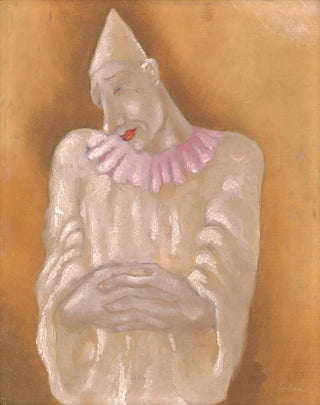Art print | Clown - Mikuláš Galanda


View from behind

Frame (optional)
In the fascinating world of art, certain works stand out for their ability to evoke deep emotions and capture the very essence of humanity. "Clown - Mikuláš Galanda" is one of these creations that, through its striking representation and intriguing atmosphere, invites the viewer to immerse themselves in a world that is both playful and melancholic. This piece, imbued with mystery, raises questions about the duality of human nature, oscillating between joy and sadness, laughter and tears. Contemplating this work, one faces a reflection of our own contradictions, making it a timeless and universal piece.
Style and uniqueness of the work
The uniqueness of "Clown - Mikuláš Galanda" lies in how the artist manages to blend elements of traditional painting with a modern and bold approach. The clown, an emblematic figure of entertainment and comedy, is depicted here with rare emotional intensity. Vibrant colors and expressive strokes breathe palpable life into this character, while the choice of shadows and lights enhances the depth of its gaze. Galanda skillfully plays with textures, creating a striking contrast between the softness of forms and the brutality of emotions. This mix of styles and techniques gives the artwork a unique dynamism, captivating the viewer's eye and mind.
The artist and his influence
Mikuláš Galanda, a prominent figure of Slovak art of the 20th century, left his mark on his era with a distinctive artistic vision. Influenced by expressionist and surrealist movements, Galanda developed a visual language that is uniquely his own, oscillating between abstraction and figuration. His work reflects an ongoing quest for truth and authenticity, seeking to reveal the hidden emotions behind appearances. Focusing on themes such as identity, solitude, and the human condition, he managed to reach a broad audience, transcending cultural boundaries. His ability to capture the essence of his subjects, as exemplified by "Clown," testifies to his artistic genius and enduring influence.

Matte finish

View from behind

Frame (optional)
In the fascinating world of art, certain works stand out for their ability to evoke deep emotions and capture the very essence of humanity. "Clown - Mikuláš Galanda" is one of these creations that, through its striking representation and intriguing atmosphere, invites the viewer to immerse themselves in a world that is both playful and melancholic. This piece, imbued with mystery, raises questions about the duality of human nature, oscillating between joy and sadness, laughter and tears. Contemplating this work, one faces a reflection of our own contradictions, making it a timeless and universal piece.
Style and uniqueness of the work
The uniqueness of "Clown - Mikuláš Galanda" lies in how the artist manages to blend elements of traditional painting with a modern and bold approach. The clown, an emblematic figure of entertainment and comedy, is depicted here with rare emotional intensity. Vibrant colors and expressive strokes breathe palpable life into this character, while the choice of shadows and lights enhances the depth of its gaze. Galanda skillfully plays with textures, creating a striking contrast between the softness of forms and the brutality of emotions. This mix of styles and techniques gives the artwork a unique dynamism, captivating the viewer's eye and mind.
The artist and his influence
Mikuláš Galanda, a prominent figure of Slovak art of the 20th century, left his mark on his era with a distinctive artistic vision. Influenced by expressionist and surrealist movements, Galanda developed a visual language that is uniquely his own, oscillating between abstraction and figuration. His work reflects an ongoing quest for truth and authenticity, seeking to reveal the hidden emotions behind appearances. Focusing on themes such as identity, solitude, and the human condition, he managed to reach a broad audience, transcending cultural boundaries. His ability to capture the essence of his subjects, as exemplified by "Clown," testifies to his artistic genius and enduring influence.






